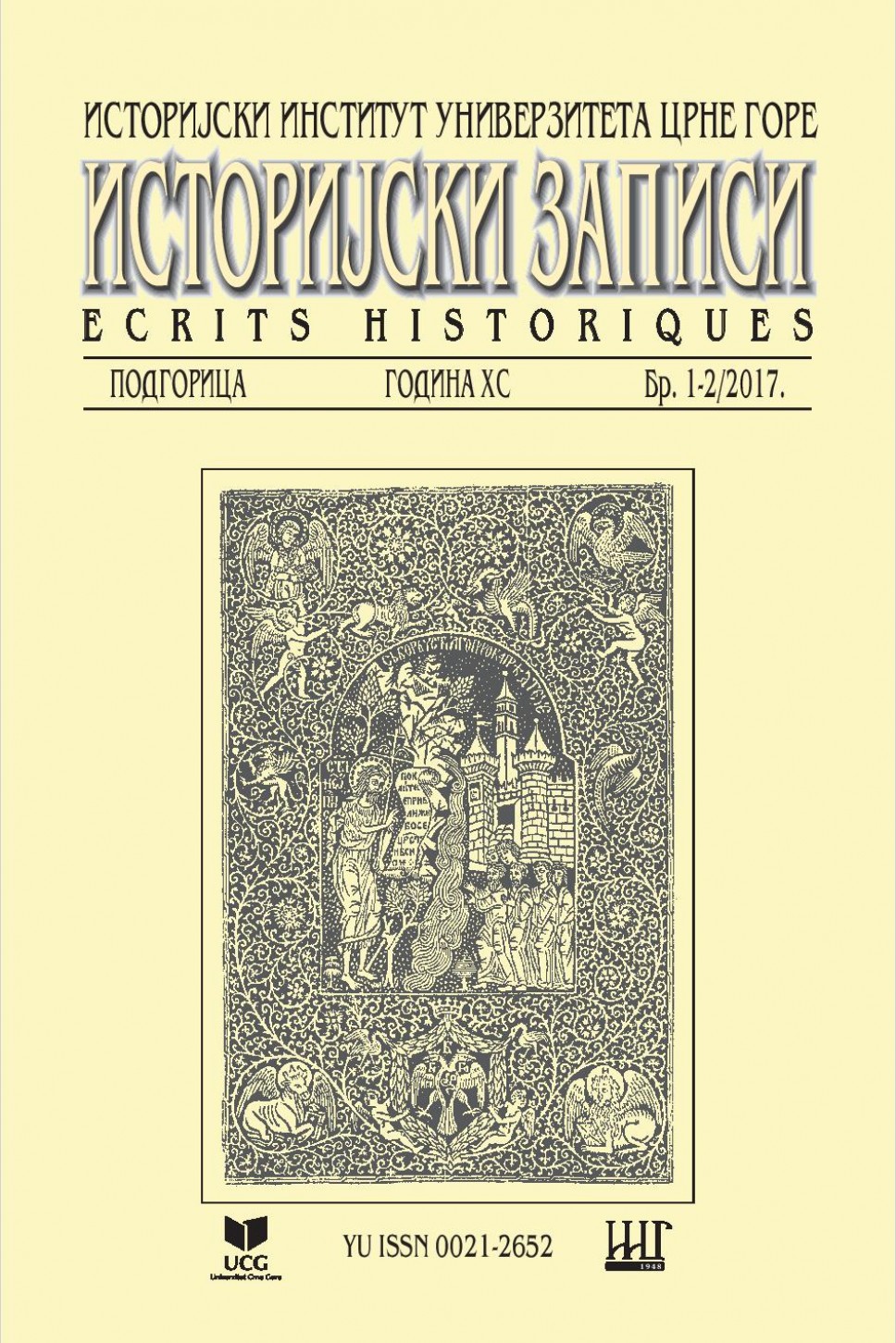ČLANCI
- Miljan GOGIĆ, Prilog proučavanju ciborijuma iz sakristije katedrale Sv. Tripuna posvećenog Petilovrijencima, 9-36 DOWNLOAD
Abstract: This work presents new information about the ciborium from the Kotor cathedral of St. Tryphon, for which a part of the scientific world believes it does not represent a whole, but rather fragments of several related ciboria. We attempt to answer the question as to whom this ciborium was dedicated and when it was erected. By analysing the available sources, it can be concluded that the ciborium was constructed during the eighth decade of the 12th century, back in the days of bishop Nikephoros II and that it was dedicated to the Kotor saints Andrew, Peter and Lawrence.
- Savo MARKOVIĆ, „Y A BUDOA PONDRÉ FUEGO“: Crnogorsko primorje u staroj španskoj i portugalskoj literaturi o Lepantskoj bici, 39-68 DOWNLOAD
ABSTRACT: Opening new areas and perspectives, multidisciplinary researches make it possible to review the existing historical knowledge. Paradigm poliphonicity is of importance not only for an integrating EuropeMediterranean present, but also for the national history and the diversity of its coexisting identities. The principles of Iberian epic from the late sixteenth century, triggered by the battle of Lepanto, reconfirmed the renaissance prestige and attractiveness of the heroic-patriotic genre, as well as of imperial ideology. The urban centers of the Montenegrin Littoral are significantly represented in the considered works, contextualizing, beside Venetian illustrative and descriptive solutions, the relating strategies and discourses.
- Saša BRAJOVIĆ, Re-prezentacije Crnogoraca Teodora Valerioa, 71-82 DOWNLOAD
ABSTRACT: Special attention was given to the presentations Famille monténégrine pleurant ses morts après un combat à l’entrée du monastère de Cettigne, Les Monténégrins se rendant au marché de Kotor and Le prêtre monténégrin en uniforme de combat, portant le drapeau de l’eglisé, created during the seventh decade of 19th century by the French artist Théodore Valério. Valério’s drawings and copper etchings modelled after them, as well as aquarelles, paintings on canvas and illustrations published in popular European magazines, display Montenegrins in a truthful manner, but also in accordance with concepts shaped within the Orientalist discourse. This is why it is emphasised that these presentations must be perceived as constructions unifying the documentary precision and imagination of the Western European understanding of the so called Orient. The analysed presentations, said in the language of contemporary literary and visual theories, are representations, i.e. representations expressing a complex relation between the observed and the observer, the connection between the truthful, the presented and what is expected from the presented. Within such a methodological framework, this text strives to answer the question asked already in 1940 by a professor and once the Director of the Historical Institute of Montenegro, Andrija Lainović: did Valério really see what he presented or are these “exotic” curiosities?
- Milena ULČAR, Magija i religija u Boki Kotorskoj Odnos sujevjerja i pobožnosti prema relikvijama u XVII i XVIII vijeku, 85-90 DOWNLOAD
Abstract: Various archival sources in the Bay of Kotor treasure information on popular religious rituals that were condemned as sinful during 17th and 18th centuries. Throughout the normative literature, such as catechisms and sermons, people susceptible to “sinful madness of magic” were severely criticized. At the same time, veneration of relics and other sacred objects became more carefully supervised, following the posttridentine regulations on practiced religion. The aim of this paper is to propose several examples of “unofficial” piety, emphasizing the flexible border between notions of religion and magic, as well as visual, somatic and verbal features shared between discussed objects and reliquaries in the Bay of Kotor.
- Aleksandra KAPETANOVIĆ, Ivan LAKOVIĆ, Tatjana KOPRIVICA, Olga PELCER-VUJAČIĆ, Graditeljska baština katuna na Kučkoj planini, 93-107 DOWNLOAD
Abstract: The paper brings an overview of the traditional built heritage of the seasonal mountain settlements, locally named katuns at Kuči Mountain in Montenegro. Here the main information on area, historical context, social and economic importance of katuns, as well as the detailed description of the main housing object – stone cottage called glada are presented. The data were collected after consulting relevant literature and conducting field researches in period 2015-2017.
PRILOZI
- Srđa MARTINOVIĆ, Vladika Visarion Borilović Bajica, crnogorski gospodar 1685-1692. godine, 111-118 DOWNLOAD
ABSTRACT: This article is about Montenegrin ruler Visarion Borilovic, his attitude towards enemies and allies. A topic about this period of history is not cover by historians and it is very important for better understanding of relations between Montenegro and Venetian Republic. After this period its coming era of Petrović-Njegoš dinasty and destiny of Montengro is changing.
- Ilija M. MIJUŠKOVIĆ, Jedan memoarski zapis o Mijajlu Nišinom Vučiniću – piperskom vojvodi, 119-126 DOWNLOAD
Abstract: The aim of this work is to make public the research of Mirko M. Mijušković1 and his presentation of Mijajle Nišin Vučinić, as well as the struggle of the Montenegrins for survival and liberation in the 19th century and the territorial expansion of Montenegro after the decisions of the Congress of Berlin in 1878.
PRIKAZI
- Saša Knežević, Srđa Martinović: „GENERALI KNJAŽEVINE I KRALJEVINE CRNE GORE“, Fakultet za crnogorski jezik i književnost, Cetinje 2016, 127-128 DOWNLOAD
- Vukajlo Gluščević, Dr Branislav Marović, KOMUNISTI CRNE GORE I CRNOGORSKO NACIONALNO PITANJE 1919 – 1989, Centar za Geopolitiku Filozofskog fakulteta, Nikšić, 2017, 129-136 DOWNLOAD

